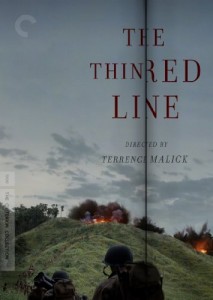 What is this war in the heart of nature? This is the question—left unanswered—at the heart of Terrence Malick’s masterpiece, The Thin Red Line. And we are all the better for it. This nearly three hour poem of cinema lingers, asks us questions about life and death, light and shadow, horror and sacrifice, presenting us with only the assurance that e are all alone in this world, yet forever linked to one another. Much to chew on for certain, and given a heightened sense of meaning in the face of war, yet the artistry of cinematographer John Toll and the direction of Malick never lets us down. It only presents the questions.
What is this war in the heart of nature? This is the question—left unanswered—at the heart of Terrence Malick’s masterpiece, The Thin Red Line. And we are all the better for it. This nearly three hour poem of cinema lingers, asks us questions about life and death, light and shadow, horror and sacrifice, presenting us with only the assurance that e are all alone in this world, yet forever linked to one another. Much to chew on for certain, and given a heightened sense of meaning in the face of war, yet the artistry of cinematographer John Toll and the direction of Malick never lets us down. It only presents the questions.
The film examines the battle for Guadalcanal during World War II. I say examines because it is not a traditional war film in any sense. Though it includes many of the staples of Hollywood war films, it transforms them into something different altogether. Moments of death come as blindly as they do in real war. Moments of heroism do so as well, but without the punctuation of the word. At one point, Sean Penn’s character lashes out at the mere suggestion that he is anything other than a soldier doing his job. Combined with the usual war film elements is Malick’s sensibility, one that adds elegiac shots of vines, dense forest, crocodiles, dying birds, and beautiful vistas. The natural is just as chaotic, the film suggests, and the wars between men are just an extension of that violence.
Although any supplemental material would have been welcome for this release, particularly in light of the massive amount of cutting that pared a six hour film to less than three and the usual refusal of Malick to add any commentary other than the film, there is plenty to be happy about here. I was a bit surprised that not much of the cut footage is presented, but what is revealed is rather good. My favorite is a scene with Mickey Rourke, his giant, soil stained hands cradling his head, his frayed words the evidence of a hard battle seen. If only this were in the film, his renaissance may have come a little sooner.
One of the true highlights of the extra features is Hans Zimmer’s interview. Taking us into the preparation of his six hours worth of music, the composer helps to paint a picture of Malick as an artist, explaining how they spoke of tones and colors as much as they did images. He even reveals that Malick basically moved into the studio for a time while Zimmer worked on the film. John Toll’s commentary with the production designer and producer is also a wonderful addition. If Malick won’t reveal any secrets, we can at least glean some information from these men, who talk about he production schedule, assembling the large cast, working with an “anthropological unit” to capture the Melanesian tribe, and the poetic vision of the director.
However, the film truly speaks for itself. The masterful cinematography of Toll is impossible to beat. The sweeping moves over the grassy hills of Guadalcanal combined with the subtle work of all the actors makes for a film that is as grand as it is insular, as bold as it is poetic.
The questions posed by the soldiers, generals, Ives, and Malick do not—and cannot—have answers. The wars between nature and between men, between ourselves—they are ongoing in various manifestations. The poetic horror of the crocodile in the first moments gives way to a single blade of life shooting out from the ground. The struggle will continue. In Malick’s vision, there is no victorious battle, no overt celebration of an army bested, at least not in any lingering sense. Instead, there is weariness and loss. Hero is just a word, victory a sham. We know that the cycle will continue. I can watch this film unfold every day a symphony of John Toll’s images, Hans Zimmer’s orchestrations and Terrence Malick’s poetry.